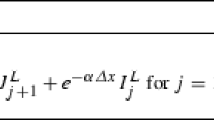Abstract
High-order finite-difference methods are appealing for large-scale numerical computations, as their excellent numerical dispersion properties enable the use of coarser grids for the modeling of uniform media. However, practical problems of interest involve, in addition to uniform media, complex boundary conditions, including curved boundaries. In fact, the lack of robust methods to incorporate curved material interfaces with consistent error performance is widely considered as a significant bottleneck in the application of high-order finite-difference techniques to practical problems. The present chapter addresses this problem, revisiting the generation of conformal, high-order finite-difference methods from the perspective of transformation electromagnetics. Fundamentally based on the metric invariance property of Maxwell’s equations, transformation electromagnetics and optics has recently been employed in the design of various cloaking media, yet it presents interesting numerical applications as well. After a brief presentation of transformation-driven numerical methods, the consistent, high-order modeling of 2/3-D curved boundaries is discussed.
Access this chapter
Tax calculation will be finalised at checkout
Purchases are for personal use only
Similar content being viewed by others
References
M. Krumpholz, L.P.B. Katehi, MRTD: new time-domain schemes based on multiresolution analysis. IEEE Trans. Microw. Theory Tech. 44(2), 555–571 (1996)
J.S. Shang, High-order compact-difference schemes for time-dependent maxwell equations. J. Comput. Phys. 153(2), 312–333 (1999)
H.M. Jurgens, D.W. Zingg, Numerical solution of the time-domain maxwell equations using high-accuracy finite-difference methods. SIAM J. Sci. Comput. 22(5), 1675–1696 (2000)
T. Dogaru, L. Carin, Multiresolution time-domain using CDF biorthogonal wavelets. IEEE Trans. Microw. Theory Tech. 49(5), 902–912 (2001)
M. Fujii, W.J.R. Hoefer, A wavelet formulation of the finite-difference method: full-vector analysis of optical waveguide junctions. IEEE J. Sel. Top. Quantum Electron. 37(8), 1015–1029 (2001)
N.V. Kantartzis, T.I. Kosmanis, T.V. Yioultsis, T.D. Tsiboukis, A nonorthogonal higher-order wavelet-oriented FDTD technique for 3-D waveguide structures on generalized curvilinear grids. IEEE Trans. Magn. 37(5), 3264–3268 (2001)
Z. Shao, Z. Shen, Q. He, G. Wei, A generalized higher order finite-difference time-domain method and its application in guided-wave problems. IEEE Trans. Microw. Theory Tech. 51(3), 856–861 (2003)
M. Fujii, M. Tahara, I. Sakagami, W. Freude, P. Russer, High-order FDTD and auxiliary differential equation formulation of optical pulse propagation in 2-D Kerr and Raman nonlinear dispersive media. IEEE J. Quantum Electron. 40(2), 175–182 (2004)
K.P. Hwang, J.Y. Ihm, A stable fourth-order FDTD method for modeling electrically long dielectric waveguides. IEEE J. Lightwave Technol. 24(2), 1048–1056 (2006)
W. Sha, Z. Huang, M. Chen, X. Wu, Survey on symplectic finite-difference time-domain schemes for maxwell’s equations. IEEE Trans. Antennas Propag. 56(2), 493–500 (2008)
M.F. Hadi, S.F. Mahmoud, A high-order compact-FDTD algorithm for electrically large waveguide analysis. IEEE Trans. Antennas Propag. 56(8), 2589–2598 (2008)
R.B. Armenta, C.D. Sarris, A general procedure for introducing structured nonorthogonal discretization grids into high-order finite-difference time-domain methods. IEEE Trans. Microw. Theory Tech. 58(7), 1818–1829 (2010)
D. Cheng-Han, C. Yih-Peng, Higher-order full-vectorial finite-difference analysis of waveguiding structures with circular symmetry. IEEE Photonics Technol. Lett. 24(11), 894–896 (2012)
R.B. Armenta, C.D. Sarris, Introducing nonuniform grids into the FDTD solution of the nonuniform transmission-line equations by renormalizing the per-unit-length parameters. IEEE Trans. Electromagn. Compat. 51(3), 818–824 (2009)
R.B. Armenta, C.D. Sarris, Modelling material interfaces and boundary conditions in high-order finite-difference methods. IEEE Trans. Microw. Theory Tech. 59(12), 3283–3293 (2011)
R.B. Armenta, The principle of coordinate invariance and the modelling of curved material interfaces in finite difference discretisations of maxwell’s equations. Ph.D. Thesis, Department of Electrical and Computer Engineering, University of Toronto, Toronto, Ontario, Canada, 2012
T.A. Driscoll, B. Fornberg, A block pseudospectral method for maxwellõs equations. I. one dimensional case. J. Comput. Phys. 140(1), 47–65 (1998)
S. Zhao, G.W. Wei, High-order FDTD methods via derivative matching for maxwell’s equations with material interfaces. J. Comput. Phys. 200(1), 60–103 (2004)
B. Yang, C.A. Balanis, Dielectric interface conditions for general fourth-order finite difference. IEEE Microwave Wirel. Compon. Lett. 17(8) 559–561, (2007)
T.A. Driscoll, B. Fornberg, Block pseudospectral methods for maxwell’s equations ii: two-dimensional, discontinuous-coefficient case. SIAM J. Sci. Comput. 21(3), 1146–1167 (1999)
S. Zhao, Full-vectorial matched interface and boundary (MIB) method for the modal analysis of dielectric waveguides. J. Lightwave Technol. 26(14), 2251–2259 (2008)
T.T. Zygiridis, T.K. Katsibas, C.S. Antonopoulos, T.D. Tsiboukis, Treatment of grid-conforming dielectric interfaces in FDTD methods. IEEE Trans. Magn. 45(3), 1396–1399 (2009)
Author information
Authors and Affiliations
Corresponding author
Editor information
Editors and Affiliations
Rights and permissions
Copyright information
© 2015 Springer Science+Business Media Singapore
About this chapter
Cite this chapter
Armenta, R.B., Sarris, C.D. (2015). Boundary Modeling and High-Order Convergence in Finite-Difference Methods. In: Ahmed, I., Chen, Z. (eds) Computational Electromagnetics—Retrospective and Outlook. Springer, Singapore. https://doi.org/10.1007/978-981-287-095-7_9
Download citation
DOI: https://doi.org/10.1007/978-981-287-095-7_9
Published:
Publisher Name: Springer, Singapore
Print ISBN: 978-981-287-094-0
Online ISBN: 978-981-287-095-7
eBook Packages: EngineeringEngineering (R0)




